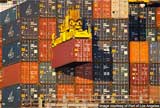| |
|
| |
|
 |
Supply
Chain by the Numbers |
| |
|
| |
- Aug. 6, 2020 -
|
| |
|
| |
|
| |
|
| |
Home Depot Rolling Out New DC Network; Low Cost Imports Now Subject to More Scrutiny; Understanding July PMI Score; Investments in Ports to Drop Sharply |
| |
|
| |
| |
| |
| |
3 |
 |
That is how many smaller scale distribution centers Home Depot is going to build in the Atlanta area, as part of the program the company announced some two years ago to build a large network of about 170 smaller distribution nodes to support same day delivery of popular items to homes and job sites. At an estimated cost back then of $1.2 billion, the network will be able to reach 90% of the US the population in just one day or even less. An interesting side to the news on the three new Atlanta DCs: Home Depot senior vice president Stephanie Smith was quoted as saying that "Less than 5% of our customer base is responsible for 45% of our sales. It's very, very important that we have a strategy for these customers." Hence the $1.2 billion investment in its fulfillment network. The new DCs in Atlanta will open next year.
|
|
|
| |
| |
|
|
|
That was the level of the Purchasing Managers Index or PMI from the Institute for Supply Management (ISM), up 1.6 percentage points from the June reading of 52.6, as announced Monday by ISM. That was nicely above the 50 mark of the index that separates US manufacturing expansion from contraction, and a bit above consensus estimates. It also represents the second straight month of expansion, in a very positive sign for the economy. Some commentators have said that the score of 54.2 for July was the highest level for index in some 17 months. That is true, but the implication of some stories is that that meant US manufacturing levels are at 17-month highs. No so. The PMI measures changes from month to month. So the score of 54.2 is in fact the highest reading for the index in 17 months, but it simply means the highest percent of companies in the PMI survey saw expansion in July versus June that at any time in the past 17 months. Actual US manufacturing output remains depressed versus pre-pandemic levels.
|
| |
| |
|
| |
| |
40% |
 |
That is the expected decline in projects to expand capacity at container shipping ports globally over the next 5 years, according to a new report from the maritime analysts at Drewry Shipping. That includes reduced spending for projects like deepening ocean channel ways, construction of new terminals, and automation of container handling. The report estimates that it expects container capacity at terminals to grow by an average 25 million containers per over that time, well below the annual average increase of more than 40 million containers added on average over the previous 10 years. The report notes that "While big port works commissioned for this and next year may be delayed, projects which are currently at an earlier stage of planning, particularly where construction contracts and equipment orders have not yet been tendered, suspension or cancellation is more likely if market conditions remain poor." Global trade could fall in 2020 by as much as 32% at the high end of the range recently provided by the World Trade Organization. |
| |
| |
| |
| |
| |
|
|
|
| |
 |
 |
| |
 |
![]() |
 |
|
| |
 |
Feedback |
|
|
|
![]()
|
No Feedback on this article yet.
|
|
![]() |
|
|
|
![]() |
 |
![]() |
 |
|
| |